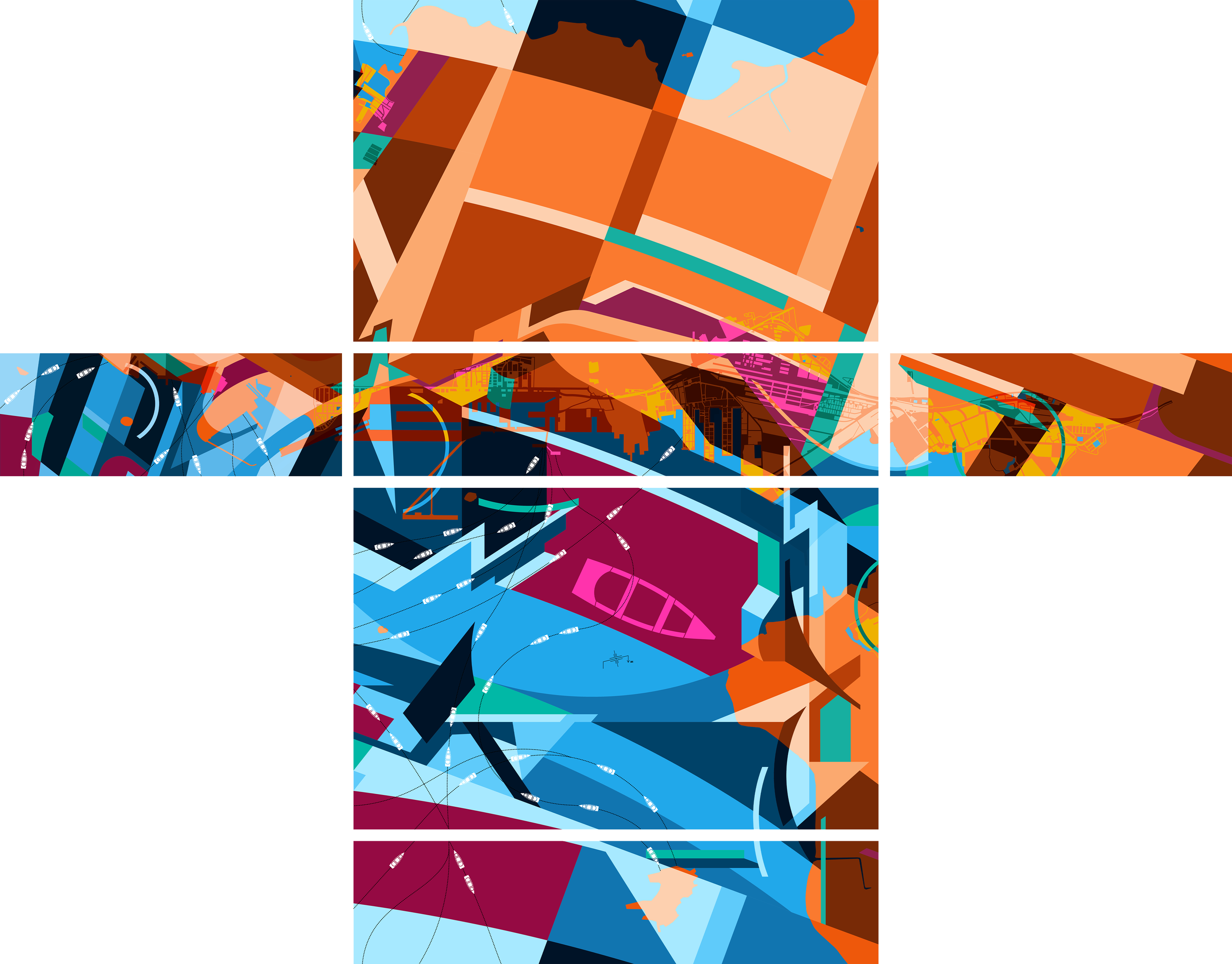
Choropleth․
The Mumbai Urban Art Festival by St+art India facilitated a novel, democratic, and expansive experience of the city of Mumbai, through landmark murals, experiential exhibitions, and immersive installations, in addition to a host of community programmes, walks, talks and more. The 2022 festival brought together a plethora of artists and diverse practitioners to create interdisciplinary projects in Mumbai. I painted a mural titled Choropleth at Sassoon Docks in Mumbai, transforming it into an art hub open to all.
Water surrounds us, encapsulates us, and defines us.
Mumbai's unique edge condition, which literally shapes the city, has also framed its historical and maritime development. The Port of Mumbai, the city's and country's first, is a crucial piece of our past. Once a critical artery to the rest of India, and even the world, the character of the port is now adapting and assimilating to the needs of our changing times. One cannot help but wonder what this means for our identity as a 'water city' and 'market city'.
My 360° abstract mural is inspired by Choropleth maps. These maps are thematic and colored, shaded, dotted, or hatched, highlighting contrasting areas to denote densities of population, trade and infrastructure. It offers a glimpse into the eternal evolution of Mumbai, its port, its history, its culture, and its people; bringing what we see outside in, at an unfamiliar scale. It presents landscapes and geographies that dwell on memory as much as they rely on flux.
This project room hosted children workshops every Saturday and Sunday during the festival. Furthermore, it features several interactive elements tailored to be inclusive and accessible to all while encouraging everyone to feel through tactile experiences.

Photographs courtesy of St+art India & Ashish Chandra
My piece aims to capture the eternal and ever-changing richness of Mumbai, it's port, it's history, it's culture, and it's people; bringing what we see outside in at an unfamiliar scale. It presents landscapes and geographies that dwell on memory as much as they rely on flux.
Thus, it draws on the traditions of storytelling - which are inherent in the very existence of Mumbai's string of ports that collectively stand as a microcosm of the city's almost-forgotten but pivotal maritime past. Simultaneously, through a completely immersive experience, the piece respects and preserves history while re-envisioning the current and future identity of the area. The interactive elements prompt visitors to patch together facts, interpretations, and even imagined details of the port's story: it's spaces, places, and faces.
As though submerged in water, we find ourselves in a sea of geometry, colour, and tales. Immersed, we are surrounded by boats, magical sounds, a soft breeze.
Enter. See. Listen. Touch. Smell. Taste.

Photographs courtesy of St+art India & Ashish Chandra
Interactive Strategies․
-
QR codes stenciled onto small boats on the walls.
Engaging the '5th sense' which is a different kind of immersive experience than what one would traditionally expect - interplay of seeing the real boats outside and the virtual boats inside.
Mobile and personal and, therefore, hugely accessible to a rapidly growing smartphone market - increases engagement and interaction and provides a richer user experience.
-
Origami paper boats filled into fishing baskets (reinforces the narrative) - each one has a hole so that it can be "fished out" from the baskets.
Each boat has a line from a poem about the city and community that lives and works at the docks - in English and Marathi.
Making of origami boats can be a workshop.
-
Select colours to be painted with blackboard paint so that children can draw on those sections with chalk during workshops and visits to the space (creating their own stories).
-
Each of the 4 columns is dedicated to a different sense - sight, smell, sound and touch.
Each sense is contained in a box to be discovered - defamiliarising the stimulus. Boxes at a wheelchair accessible height.
The stimulus is connected to the history/culture of Mumbai's ports (ex. spices>smell; cotton>touch).
-

Augmented Reality
Engaging the '5th sense' which is an unexpected immersive experience - interplay of seeing the real boats outside and the virtual boats inside
-

Paper Boats
Origami paper boats filled into fishing baskets. Each boat has a line from a poem about the city and community that lives and works at the docks.
-

Blackboard Paint
Select colours to be painted with blackboard paint so that children can draw on those sections with chalk during workshops and visits to the space.
-

Sense Boxes
Each of the 4 columns is dedicated to a different sense - sight, smell, sound and touch. Each sense is contained in a box to be discovered.










Video courtesy of Jay Upadhyay
Press Coverage․
Four curated art exhibits at Mumbai Urban Art Festival which are unmissable, Mid-Day, January 2023
Mumbai Urban Art Festival aims to become a biennale, Mint Lounge, February 2023
Mumbai Urban Art Festival returns to the docks with St+art India & Asian Paints, Stir World, December 2022
St+art India and Asian Paints launch Mumbai Urban Art Festival (MUAF), Global News Network of India, December 2022
Mumbai’s Sassoon Docks open its rich culture and ecosystem to the Urban Art Festival, Icon, February 2023
Mumbai Urban Art Festival, Festivals from India







